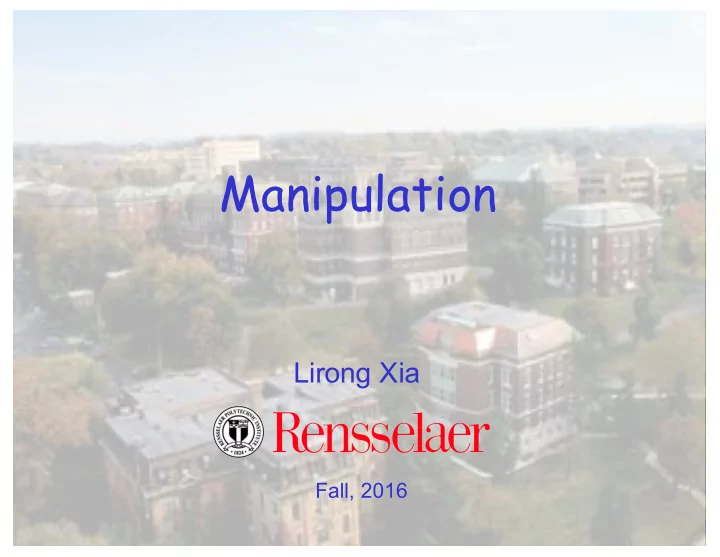

Manipulation Lirong Xia Fall, 2016
Manipulation under plurality rule (lexicographic tie-breaking) > > Alice > > Plurality rule Bob > > Carol > >
Strategic behavior (of the agents) • Manipulation: an agent (manipulator) casts a vote that does not represent her true preferences, to make herself better off • A voting rule is strategy-proof if there is never a (beneficial) manipulation under this rule
Using Borda? Alice > > Bob > > • Inverse the tie-breaking order? 4
Using STV? > > × 4 > > × 2 × 2 > > • N>M>O à O>M>N 5
Any strategy-proof voting rule? • No reasonable voting rule is strategyproof • Gibbard-Satterthwaite Theorem [Gibbard Econometrica-73, Satterthwaite JET-75] : When there are at least three alternatives, no voting rules except dictatorships satisfy – non-imposition: every alternative wins for some profile – unrestricted domain: voters can use any linear order as their votes – strategy-proofness • Axiomatic characterization for dictatorships! • Randomized version [Gibbard Econometrica-77]
A few ways out • Relax non-dictatorship: use a dictatorship • Restrict the number of alternatives to 2 • Relax unrestricted domain: mainly pursued by economists – Single-peaked preferences: – Range voting: A voter submit any natural number between 0 and 10 for each alternative – Approval voting: A voter submit 0 or 1 for each alternative 7
Single-peaked preferences • There exists a social axis S – linear order over the alternatives • Each voter’s preferences V are compatible with the social axis S – there exists a “peak” a such that • [b ≺ c ≺ a in S] implies [c ≻ b in V] • [a ≻ c ≻ b in S] implies [c ≻ b in V] • alternatives closer to the peak are more preferred – different voters may have different peaks 8
Examples rank Axis 9
Strategy-proof rules for single-peaked preferences • The median rule – given a profile of “peaks” – choose the median in the social axis • Theorem. The Median rule is strategy-proof. • The median rule with phantom voters – parameterized by a fixed set of “peaks” of phantom voters – chooses the median of the peaks of the regular voters and the phantom voters • Theorem. Any strategy-proof rule for single-peaked preferences are median rules with phantom voters • Talk announcement: Dominik Peters 9/21 3-4pm Sage 3713 10
Computational thinking • Use a voting rule that is too complicated so that nobody can easily predict the winner – Dodgson – Kemeny – The randomized voting rule used in Venice Republic for more than 500 years [Walsh&Xia AAMAS-12] • We want a voting rule where – Winner determination is easy – Manipulation is hard • The hard-to-manipulate axiom: manipulation under the given voting rule is NP-hard 11
Example 3: Venetian election (1268--1797) ∼ 1000 lottery • Round 1: lottery • Round 2: Approval like voting • Round 3: … Plurality 12 • Round 10: The winner must receive >24 votes
Manipulation: A computational complexity perspective If it is computationally too hard for a manipulator to compute a manipulation, she is best off voting truthfully – Similar as in cryptography NP- Hard For which common voting rules manipulation is computationally hard? 13
Unweighted coalitional manipulation (UCM) problem • Given – The voting rule r – The non-manipulators’ profile P NM – The number of manipulators n’ – The alternative c preferred by the manipulators • We are asked whether or not there exists a profile P M (of the manipulators) such that c is the winner of P NM ∪ P M under r 14
The stunningly big table for UCM #manipulators One manipulator At least two Copeland P [BTT SCW-89b] NPC [FHS AAMAS-08,10] STV NPC [BO SCW-91] NPC [BO SCW-91] Veto P [ZPR AIJ-09] P [ZPR AIJ-09] Plurality with runoff P [ZPR AIJ-09] P [ZPR AIJ-09] Cup P [CSL JACM-07] P [CSL JACM-07] [DKN+ AAAI-11] Borda P [BTT SCW-89b] NPC [BNW IJCAI-11] Maximin P [BTT SCW-89b] NPC [XZP+ IJCAI-09] Ranked pairs NPC [XZP+ IJCAI-09] NPC [XZP+ IJCAI-09] Bucklin P [XZP+ IJCAI-09] P [XZP+ IJCAI-09] Nanson’s rule NPC [NWX AAA-11] NPC [NWX AAA-11] Baldwin’s rule NPC [NWX AAA-11] NPC [NWX AAA-11] 15
What can we conclude? • For some common voting rules, computational complexity provides some protection against manipulation • Is computational complexity a strong barrier? – NP-hardness is a worst-case concept 16
Recommend
More recommend